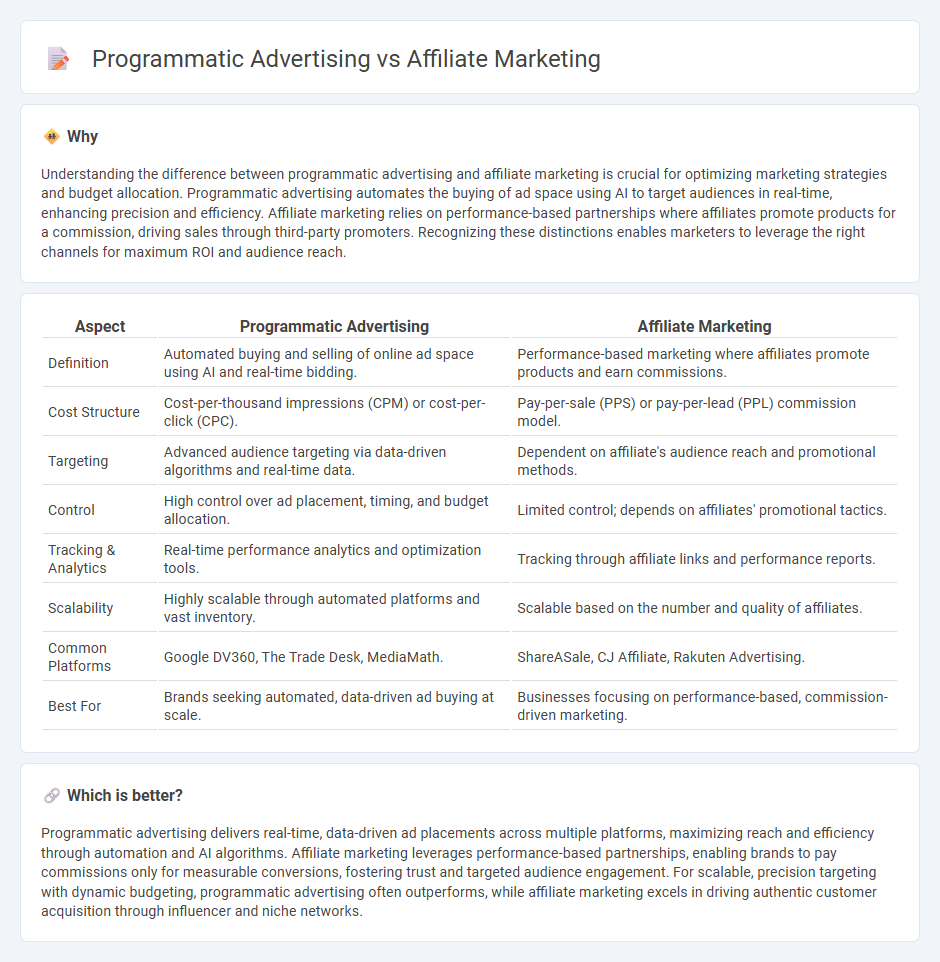
Programmatic advertising automates the buying of digital ad space using AI and real-time bidding, delivering highly targeted ads to specific audiences across multiple platforms. Affiliate marketing relies on performance-based partnerships where affiliates promote products and earn commissions on sales generated through their unique links. Explore the distinct advantages and strategies of both methods to optimize your marketing campaigns.
Why it is important
Understanding the difference between programmatic advertising and affiliate marketing is crucial for optimizing marketing strategies and budget allocation. Programmatic advertising automates the buying of ad space using AI to target audiences in real-time, enhancing precision and efficiency. Affiliate marketing relies on performance-based partnerships where affiliates promote products for a commission, driving sales through third-party promoters. Recognizing these distinctions enables marketers to leverage the right channels for maximum ROI and audience reach.
Comparison Table
| Aspect | Programmatic Advertising | Affiliate Marketing |
|---|---|---|
| Definition | Automated buying and selling of online ad space using AI and real-time bidding. | Performance-based marketing where affiliates promote products and earn commissions. |
| Cost Structure | Cost-per-thousand impressions (CPM) or cost-per-click (CPC). | Pay-per-sale (PPS) or pay-per-lead (PPL) commission model. |
| Targeting | Advanced audience targeting via data-driven algorithms and real-time data. | Dependent on affiliate's audience reach and promotional methods. |
| Control | High control over ad placement, timing, and budget allocation. | Limited control; depends on affiliates' promotional tactics. |
| Tracking & Analytics | Real-time performance analytics and optimization tools. | Tracking through affiliate links and performance reports. |
| Scalability | Highly scalable through automated platforms and vast inventory. | Scalable based on the number and quality of affiliates. |
| Common Platforms | Google DV360, The Trade Desk, MediaMath. | ShareASale, CJ Affiliate, Rakuten Advertising. |
| Best For | Brands seeking automated, data-driven ad buying at scale. | Businesses focusing on performance-based, commission-driven marketing. |
Which is better?
Programmatic advertising delivers real-time, data-driven ad placements across multiple platforms, maximizing reach and efficiency through automation and AI algorithms. Affiliate marketing leverages performance-based partnerships, enabling brands to pay commissions only for measurable conversions, fostering trust and targeted audience engagement. For scalable, precision targeting with dynamic budgeting, programmatic advertising often outperforms, while affiliate marketing excels in driving authentic customer acquisition through influencer and niche networks.
Connection
Programmatic advertising uses automated technology to purchase ad space, optimizing targeting and real-time bidding, which enhances affiliate marketing by driving highly relevant traffic to affiliate offers. Affiliate marketing leverages performance-based partnerships where affiliates promote products, benefiting from programmatic ads that increase conversion rates through precise audience segmentation. Integrating programmatic advertising boosts affiliate marketers' efficiency by delivering personalized content and measurable outcomes, thus maximizing ROI.
Key Terms
Commission
Affiliate marketing operates on a commission-based model where affiliates earn a percentage of sales generated through their referral links, incentivizing performance-driven promotions. Programmatic advertising involves automated buying of ad space using real-time bidding, with costs usually based on impressions or clicks rather than direct sales commissions. Explore how commission structures impact marketing ROI by learning more about these strategies.
Real-Time Bidding (RTB)
Affiliate marketing leverages partner websites to drive sales through tracked referrals, while programmatic advertising automates ad buying using data-driven algorithms. Real-Time Bidding (RTB) facilitates programmatic ad space auctions, enabling advertisers to target specific audiences with precision and efficiency, often yielding higher ROI. Discover the strategic advantages of RTB in transforming digital marketing approaches.
Publisher
Affiliate marketing empowers publishers to earn commissions by promoting specific products through tracked links, incentivizing performance-based revenue. Programmatic advertising enables publishers to maximize ad inventory revenue by automating real-time bidding and delivering targeted ads to audience segments. Explore how these strategies can optimize your publishing revenue streams effectively.
Source and External Links
What Is Affiliate Marketing and How to Get Started - Affiliate marketing is a model where third-party publishers promote a merchant's products and earn commissions from sales or traffic generated, offering a cost-effective marketing strategy for businesses and income opportunities for affiliates.
Affiliate Marketing 101: What it is and How to Get Started - Affiliate marketing involves three parties: the seller/product creator, the affiliate who promotes the product, and the consumer; affiliates earn commissions by persuading target audiences to purchase the products they promote.
Affiliate Marketing Guide: All You Need To Know (2025) - Affiliates earn commissions by sharing unique tracking links for products or services, and beginners can start by choosing niches, platforms, joining affiliate programs, creating valuable content, and building an audience while adhering to FTC guidelines.
 dowidth.com
dowidth.com